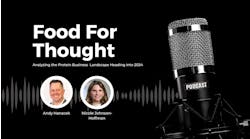Welcome to another episode of Food For Thought, a podcast where the Food Processing team takes you behind the scenes of the food and beverage industry. This week, I sat down with Editor in Chief Dave Fusaro and Senior Editor Pan Demetrakakes to talk about our biggest story each year: The Food Processing Top 100. Listen in as we talk about this year’s list, including our discussion of the how, the who, and the why of the biggest food companies in the U.S. and Canada. We also get an update on how food and beverage companies are handling the coronavirus pandemic at their facilities and whether or not comfort food will be around for the long haul.
Transcript
Erin: Dave, we just released the 45th annual list of the top food and beverage companies. Can you give us a 30,000-foot view of how things look for food right now?
Dave: Yeah. Sure. But first, let me explain where these figures come from because they are unique to food processing and our thought process here. We rank these companies by U.S. value-added consumer-ready, not necessarily branded, but consumer-ready food and beverage products that were produced in U.S. and Canadian manufacturing plants. There's a lot of qualifiers I realize, but we're trying to rank these companies as North American food manufacturers, not necessarily marketers. So, Pepsi, even though their first one on the list and they have $67 billion worth of sales as a total company, only about a little more than half, $41 billion are made in the U.S. and Canadian manufacturing plants. They're still number one on the list, but we don't give them credit for the entire $67 billion. Cargill, if we listed companies by their total sales, Cargill, which has ocean-going vessels and iron ore mines and train cars all over the world, they would be number one at $113 billion.
But we think of Cargill only as the meat company. So, instead of being number 1, they're number 13 with sales of just, well, an estimated $8.9 billion. ADM isn't on the list at all. And, you know, because they're an agricultural company, nothing they do is in a consumer-ready form. Monster Beverage and KIND Snacks aren't in the list because they don't manufacture a single product of their own. Everything they do is done by contract manufacturers. And while it's a great list, a scorecard of 100 teams if you will, collectively, it does give a picture of the financial health of the food and beverage industry. And that setup right now looks pretty good for big food because 45 of these 100 companies saw sales increases in whatever fiscal year just ended for them. And only 13 reported decreases. Now, the rest were all within a plus or minus 5%. So, sorry. Finally, getting to answer your question, they had a pretty respectable 2019, which is where most of these figures come from and most are having a phenomenal first half of 2020 because of the pandemic.
Erin: That's great. So, was there anything unusual about this year's list? Anything that jumped out at you or surprised you?
Dave: Nothing terribly unusual, but there were some nice surprises in it. In terms of sales, General Mills, which has been struggling in the last couple of years, they were up nearly a billion dollars in sales in their fiscal 2020. They actually had a fiscal year that ended May 31st and we were able to get that figure in. There are two caveats to that, they bought a billion dollars in sales when they bought Blue Buffalo in 2018. And, yeah, the figure we used was a fiscal 2020 figure, so that includes the first five months of this year, which were very good months for most of the big food companies. Conagra went through several years of planned shrinkage as they divested businesses that were underperforming or just didn't fit the new strategy. But they made a huge 2018 acquisition to Pinnacle Foods. So, with a full year of Pinnacle under its belt, Conagra's sales were up $1.5 billion, 16% up.
Now, Anheuser-Busch didn't increase its North American sales earning, but parent AB InBev. Their profits doubled from $4.4 billion in 2018 to $9.2 billion in 2019. Some other profits stories were interesting. Kraft Heinz turned around at $10 billion loss in 2018 to nearly $2 billion in profit in 2019. Although their 2018 loss was mostly due to financial things, write-down to some of the value of the brands. Brazilian meat company, JBS, for years has been struggling to make profits because of so many acquisitions, but it went from only $79 million in profits in 2018 to $1.5 billion in 2019. That's a pretty nice turnaround for them. On the other hand, though, Constellation Brands, which has just been awash in profits in recent years, they decided to invest all those profits in a Canadian cannabis company, Canopy Growth, which for 2019 dragged down its profitability. So, instead of $3 billion in profits Constellation Brands had in 2018, they had just $21 million in 2019.
Erin: I know that when getting this ready for all of the online stuff that we do with the list that we had a few companies fall off, which obviously lent some room to adding a few on to the list, what should we know about these newcomers to the top 100?
Dave: Yeah. Companies come and go every year and this year we lost a few. Now, Dean Foods, which you know, had filed for bankruptcy, they're off the list. They're now part of...most of it is a part of Dairy Farmers of America. Keystone Foods, which is now a part of Tyson and Cott Corporation, another one that dropped off the list. They divested almost all of their packaged beverage business and now essentially a water delivery company. So, those are three names that disappeared from the list this year. And we replaced them with companies that should've been on the list all along, but they're private, very privately-held companies. Wonderful Company, the maker of, you know, pistachios and the Cuties, and some more value out of Fiji Water, for instance. Ocean Spray, I never realized they had a billion dollars in value-added snacks and beverages, you know, not just commodity, cranberries. And Mountain Farms, one of those...there are many of these privately-held poultry companies that, you know, there's $2 billion and just we never had them on our radar before.
Erin: Yeah. It was definitely an interesting list this year, for sure. I know we've worked in tandem on this for over a decade and it's always interesting to see how the list evolves.
I want to switch gears a little bit and go into how, you know, last month on this podcast, we were talking about how the pandemic was impacting labor in food and beverage. So, Pan can you give us an update on where things are one month later?
Pan: Well, from where I'm sitting, things are still tense and they're gonna stay that way for the foreseeable future, especially in the meat and poultry sector. There currently is a lawsuit by the United Food and Commercial Workers Union, which is the largest union that represents meat packaging workers to overturn a USDA waiver that allowed faster speeds in poultry plants during the crisis. And also legislation has been introduced by Democratic senators and representatives that would roll back waivers on line speeds that the USDA has granted over the years to pork and other meat and poultry processing plants. So, line speeds is the big issue here. It has been for a long time for many years before the pandemic, but the pandemic has just brought the situation into a sharper relief. And the situation is very tense and it's going to stay that way as long as workers have legitimate fears for their health and even their lives in coming to work. And so, basically, that's going to stay there until the pandemic goes away or is brought under control. That's not a very rosy assessment, but I can't think of any other way to say it.
Erin: what considerations should companies be making for the longer-term as it relates to how their plants are designed or set up?
Pan: Well, that's the $64,000 question, or should I say the $64 million question? I don't know. And I'm not sure that anybody really does. Forty-five minutes before we started doing this podcast, I put up a news item about how Schwan's, the frozen pizza company that makes Red Baron and Tony's and other big frozen pizza brands, they are massively expanding their plant in Salina, Kansas, which at 550,000 square feet is already the biggest frozen pizza plant in the world. Now, in their release announcing this, they said that the plan will include, "Investment in technology and protocols designed to minimize the risks during pandemic situations." Now, I would dearly love to know exactly what that means and what they have in mind because it's becoming increasingly clear that keeping people distant, social distancing is one of the only truly effective ways to suppress the pandemic. But that's precisely what is difficult or impossible in most food plants as they're currently constructed. As I think I said in the last podcast, plants are designed in terms of microbial safety to keep the food from being contaminated. Nobody ever thought that they would be in a situation where the workers have to be protected from contaminating each other.
Now, for future plans, it really depends on how much danger you think there is of a new pandemic coming along in the next 10 or 15 or 20 years or beyond. And it's a very cruel dilemma because if you decide to go full safety and institute social distancing for your workers on a permanent basis, that is going to add tremendously to the cost of the plant. Other strategies to enable social distancing such as line slowdowns, speed slowdowns, and automation will also be expensive. And so, the person who's planning the new plant has to predict, do I want to sink all of these costs into my plant to be prepared for the next pandemic? What happens if the next pandemic doesn't materialize? Well, then I'd sunk all of these costs into my plant that I've put myself at a competitive disadvantage. So, all I can say is I am very glad that I am not in charge of designing a new meat plant or other kinds of food plants right now.
Erin: It'll be interesting to watch for sure. So, we're five months deep into the pandemic and we've seen and heard the toll COVID-19 has taken on the labor market for food facilities. But what about the supply chain? What has to be done to straighten out for the long-term the kinds of kinks in the supply chain we've seen during the pandemic?
Pan: Well, the biggest problem that we've seen so far is that the supply chain has proved inelastic. There are too many choke points and it's being too hard in many cases to make the pivot between foodservice and retail. When I say too many choke points, what I mean is that production, especially in the meat sector, has become centralized to the point where if you take even a handful of plants offline, that will have profound effects on the meat supply. You look at other countries like Mexico where production is much more decentralized and they didn't experience the kinds of interruptions that the United States did. Now, meat production got centralized the way it did for a reason because it's efficient and it gives consumers what they want, which is cheap product. And I don't really think that as a matter of public policy, that the United States or any state government can mandate decentralization in the meat industry. That's just not how we roll. We don't tell private industry what to do. So, the only thing I can think of is that if the current setup that has proved inadequate or problematic to meet the demands of the pandemic should go on causing problems and there's just going to have to be a market-based remedy.
Be sure to cast your vote for our 2020 Green Plant of the Year. We’ve got four contenders: Chobani, OSI Group, Danone North America, and Bimbo Bakeries, USA. The winner will be featured in the October issue and an upcoming episode. of the podcast.
The industry's gonna have to evolve to such a point where the choke points don't exist or don't exist to the extent that they do. And as for the pivot between foodservice and retail, we saw that especially badly in the dairy sector because a lot of dairy processing was set up specifically for foodservice, especially the of milk that kids drink in their lunches and foodservice cheese. A lot of the American milk supply gets consumed in cheese for pizza, cheeseburgers, whatever restaurant wants to put cheese on. When that got interrupted, the processing plants had a hard time making the shift to retail where the demand existed. So, in future, the only thing I can think of is the industry will probably want to look at building greater flexibility into the system perhaps through packaging automation, and also the government ought to think about what it can do from a regulatory standpoint to make these kinds of pivots easier to enable packaging, maybe to switch between foodservice and retail with not quite so many labeling and other requirements. And so, yeah, the supply chain is going to be a major issue. And I think that it's going to work itself out according to market forces and hopefully with some intelligent guidance on the part of the government.
Erin: Okay. Well, speaking of pivots, let's do a soft pivot into products and product availability. What consumption trends have you noticed in the last few months that are starting to take shape?
Pan: Well, the most overwhelming one I think in terms of its impact on the industry is that more people are cooking their own food and eating it at home. And that directly accounts, in my opinion, for the surge that we've seen in retail sales simply because going out to restaurants is a reduced option. And so, obviously, this affects companies directly in terms of what they make, do they make grocery food service or convenience store products? The more grocery and the less foodservice and convenience store products there are the better, and that has almost a direct correlation in the quarterly reports that are starting to come in. There's just is almost a direct correlation between the presence that a company has in retail and foodservice respectively, and its performance in the last quarter. Now, the other trend that we've seen is related to the first one, and that's an increase in comfort foods. For a long time, consumers, or so the conventional wisdom went, were striving to eat healthier and were abandoning the so-called comfort foods of their use in many cases that were high in sugar or salt, fat, whatever. However, this seemed to be turning back to them. I think you have just one statistic, Eggo waffles, the frozen waffles from Kellogg in the second quarter, sales were up 26% over the same quarter for the last year.
Erin: Do you think those trends will stick around for the long haul?
Pan: I have to believe that the cooking at home trend probably will. I mean, I don't think that once this all goes away, may that blessed day arrive soon, I don't think that once this goes away that people will cook at home maybe quite as much as they are now. However, once you've developed a knack, you never really lose it. And people are going to see that being able to expand the repertoire of at-home meals gives them the versatility they need to, you know, feed their family better and especially to save money. Now, that's why I think this trend is really going to last because, for a long time, we're going to be seeing a lot of economic fallout. There is and there will be a lot of economic insecurity. People will be looking to cut spending wherever they can and cooking at home is a great way to do that. Now, as for comfort foods, that one I'm not sure about, simply because people still have scales in their homes. You know, they're going to...there's already jokes about the COVID-19 meaning the 19-pound weight gain. So, I'm purely speculating here, but I think it's possible that people might decide that their waistlines need a break and so they would ease up on the comfort foods. But as I said, that's pretty much just a guess on my part.
Erin: Yeah. It seems like these last four months of the year seemed like they're going to be anyone's guess entirely.


